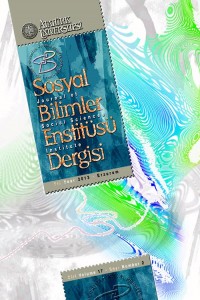Abstract
The art of painting in the 20th century is the product of the formations that have been parallel to social developments that have tried to keep up with the speed of the dazzling radical changes created by the technology developed with the help of primary “Avant-garde” ideas. Extreme ideas and new formations have led the art and the artists to experience extremity. Newly discovered art branches, styles, composition fictions, harmonies and different materials have led to emerging of the intertwined differences parallel to each other. As a result of these interactions, Paul Klee became one of the artists who peaked the artistic susceptibility and grew prodigiously with their excitements. Paul Klee always pursued the independent in order to create his own style and saw it as a means to achieve his goal. The intellectual creations of the artist, combining with the language of music, have become a significant means in the transformation and analyse of the stylistic language of the painting and in achieving the reality, “essence”, in the art. Klee’s goal to “make invisible visible” gained depth with the discovery of Bach’s music and became an important factor in achieving the main, “Pure”, reality he sought in order for the solution of the stylistic pursuits in art.
References
- Düchting, H. (2002). Paul Klee Painting Music. Munich-London-New York: Prestel Verlag.
- Eroğlu, Ö. (2013). Paul Klee’de Düşünsellik. Online erişim: http://www.ozkaneroglu. com/readessay.asp?id=73&catalog=2
- İpşiroğlu, N. (1995). Resimde Müziğin Etkisi (2. Basım). İstanbul: Remzi Kitapevi.
- İpşiroğlu, N. (2002). 20.Yüzyıl Sanatında J.S. Bach. İstanbul: Pan Yayıncılık.
- İpşiroğlu, N. (2010). Görsel Sanatlarda Alımlama ve Sanatlar Arası Etkileşim. İstanbul: Hayalbaz Kitap.
- Lionel, R. (2005). Ekspresyonizm Sanat Ansiklopedisi (4. Basım). İstanbul: Remzi Kitapevi.
- Sérullaz, M. (2004). Empresyonizm Sanat Ansiklopedisi (4. Basım). Çev: Devrim Erbil. İstanbul: Remzi Kitapevi.
- Toros, A. (1991). “Paul Klee”. Adam Sanat Dergisi, Sayı: 65, Nisan 1991.
- Tunalı, İ. (2003). Felsefenin Işığında Modern Resim (6. Basım). İstanbul: rh+ Yayınları.
Abstract
References
- Düchting, H. (2002). Paul Klee Painting Music. Munich-London-New York: Prestel Verlag.
- Eroğlu, Ö. (2013). Paul Klee’de Düşünsellik. Online erişim: http://www.ozkaneroglu. com/readessay.asp?id=73&catalog=2
- İpşiroğlu, N. (1995). Resimde Müziğin Etkisi (2. Basım). İstanbul: Remzi Kitapevi.
- İpşiroğlu, N. (2002). 20.Yüzyıl Sanatında J.S. Bach. İstanbul: Pan Yayıncılık.
- İpşiroğlu, N. (2010). Görsel Sanatlarda Alımlama ve Sanatlar Arası Etkileşim. İstanbul: Hayalbaz Kitap.
- Lionel, R. (2005). Ekspresyonizm Sanat Ansiklopedisi (4. Basım). İstanbul: Remzi Kitapevi.
- Sérullaz, M. (2004). Empresyonizm Sanat Ansiklopedisi (4. Basım). Çev: Devrim Erbil. İstanbul: Remzi Kitapevi.
- Toros, A. (1991). “Paul Klee”. Adam Sanat Dergisi, Sayı: 65, Nisan 1991.
- Tunalı, İ. (2003). Felsefenin Işığında Modern Resim (6. Basım). İstanbul: rh+ Yayınları.
Details
| Primary Language | tr;en |
|---|---|
| Authors | |
| Publication Date | January 3, 2014 |
| Published in Issue | Year 2013 Volume: 17 Issue: 2 |

